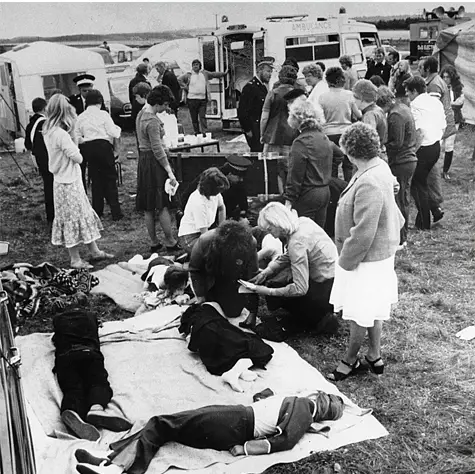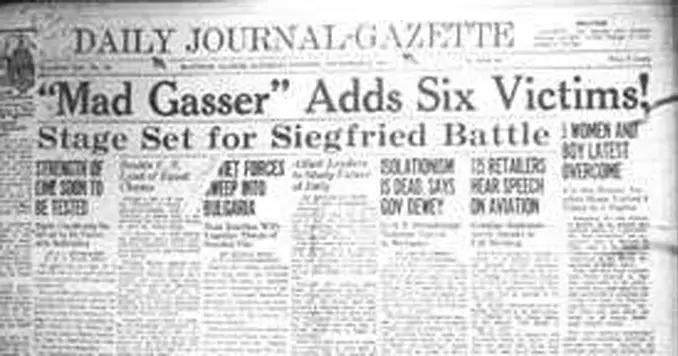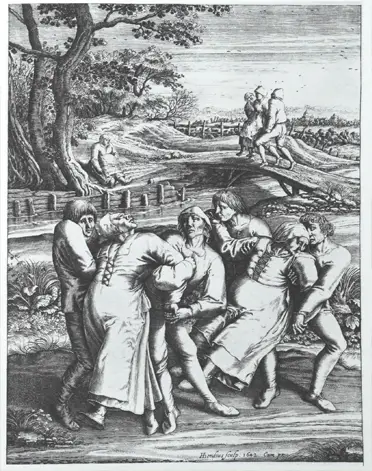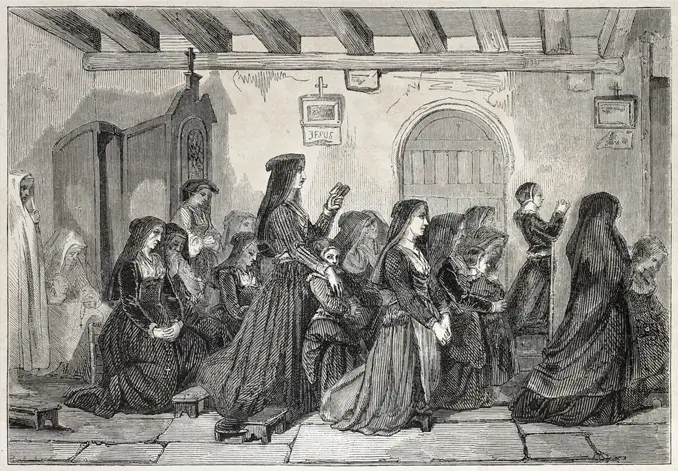Think you’re immune to mind control? Think again! A phenomenon known as mass hysteria can cause even the most clear-headed thinker to fall under the spell of group thinking. Mass hysteria is a psychological and social phenomenon that causes a group of people to experience the same collective “delusion”. There have been several notable examples of mass hysteria throughout history that have left people baffled. Let’s explore freaky examples of mass hysteria historians can’t explain!
6. The Hollinwell Incident

Location: Nottinghamshire, England
Date: July of 1980
Number of People Involved: 300
July 13 1980 started as an exciting day at the Hollinwell Showground near Kirkby-in-Ashfield. This was the day that eager students belonging to the Forest League of Juvenile Jazz Bands were scheduled to host a charity event at the annual Hollinwell Show. However, something eerie soon took place that still has not been explained.
First, a little background. Nearly 500 kids from close to a dozen different marching bands showed up that day to perform for guests arriving from near and far! Things were off to a great start as the band members practiced and prepared for the event. However, something had gone horribly wrong by the time the clock struck 10:30 a.m. This was about the time when the young band members began to drop to the floor.
Around 300 children began fainting on mass for no apparent reason. Victims of the bizarre fainting spell reported dizziness, vomiting, eye pain, headaches, bodily weakness and sore throats. Hundreds of people in attendance at the event had to be hospitalized. What was it in the air at the Hollinwell Showground that caused so many to faint?
Following years of research, the most likely conclusion is mass hysteria. Following the incident, the Ashfield District Council investigated a list of likely causes that included everything from contaminants and food poisoning to radio waves and pesticides. There has been some enduring speculation that pesticide poisoning by way of Calixin that had recently been used to spray crops in the area could be to blame. Those who favor mass hysteria as an explanation believe that a jittery student may have set off a chain reaction that created a “mass psychogenic illness”.
5. The Tanganyika Laughter Epidemic

Location: Kashasha, Tanganyika
Date: Jan. 30 of 1962
Number of People Involved: Up to 1,000
Laughter may be the best medicine for everything except mass hysteria. In January 1962, a laughter epidemic broke out at an all-female boarding school near Lake Victoria in Tanganyika, now known as Tanzania. Starting with just three girls, it soon spread to 95 out of 150 at the school. Some were infected for a few hours, but others were struck for a 16 full days. Curiously, the teaching staff remained thoroughly unamused during the ordeal. They were unable to continue their lessons due to the fanfare.
The laughing spell at the private school could not be contained. It spread into town to affect as many as 1,000 people! 14 other schools in the area were forced to shut down. What’s more, the symptoms evolved to include fainting, breathing issues, nausea, rashes and screaming. Villagers were so upset by the ordeal that they sued the Kashasha school several times for allowing the disease to spread!
What was so funny that thousands of people were struck by a laughing illness? It turns out the laugher hysteria was probably caused by stress. In 1962, students in Kashasha had a lot on their minds. For one, this was the year that Tanganyika became independent. Second, girls at the school that served as the “infection site” had recently reported feeling stressed by the strict standards of their teachers. It turns out that laughing is a common psychological response to stress. It is most often seen in people who feel “powerless” to express the way they feel because it creates a signal for distress without verbal expression. Make sense now, doesn’t it?
4. Mass Hysteria: The Mad Gasser of Mattoon

Location: Mattoon, Illinois
Date: 1940s
Number of People Involved: An entire town
A never-identified perpetrator may have been responsible for a series of gas attacks on more than 24 people in Mattoon, Illinois, during the 1940s. Over the span of two weeks, more than 24 separate incidents involving the smell of “strange gas” were reported to authorities in Mattoon. Several people also reported seeing a mysterious assailant accompanying these smells. The typical “sighting” of the gasser included the sudden appearance of a gas-like smell followed by bizarre symptoms that ranged from coughing to paralysis. Fortunately, all the victims recovered quickly without any signs of long-term damage.
Several people claimed the gasser was a tall, thin man dressed in black clothing. He was spotted at least one time carrying a tool known to be used for spraying pesticides. One victim even claimed he broke into her bedroom to attempt to gas her. However, the majority of the victims were unable to provide clear descriptions. The accounts were never enough to help police track down a perpetrator. What’s more, police were never able to detect any chemicals at the crime scenes.
The four primary conclusions that people reach are: the incident was the result of industrial pollution blanketing the area; there was an attacker on the prowl; a supernatural event was taking place; or the town was subject to a case of mass hysteria. It is worth stating that a nearby plant managed by Atlas-Imperial contained a stock of carbon tetrachloride. Some speculate that the wind may have simply carried odors to the windows and doorsteps of Mattoon residents.
3. The “Strawberries With Sugar” Virus

Location: Portugal
Date: May of 2006
Number of People Involved: 300
Did 300 kids in Portugal become infected with a “television” virus? Parents and school officials were concerned when students began exhibiting troubling symptoms like dizziness, breathing difficulties and rashes out of the blue. The mysterious illness quickly spread to more than 14 schools throughout Portugal. Oddly, adults seemed to be immune to the illness. What could be the explanation?
The “outbreak” of this mysterious illness began just days after an episode of an ultra-popular teen show called “Morangos com Açúcar” (“Strawberries with Sugar”) ran an episode about a virus that was making students sick. Ultimately, Portuguese health officials could find no cause for the symptoms that teens were experiencing in real life, other than the influence of a teen drama show. The director of the Portuguese National Institute for Medical Emergency ultimately chalked the phenomenon up to mass hysteria triggered by a few students with legitimate allergies exhibiting symptoms that reminded other students of what they’d seen on television. The mysterious illness had completely disappeared just a few weeks after the “sickening” episode aired.
2. The Meowing Nuns
Location: Europe
Date: The 15th century
Number of People Involved: Possibly hundreds
This next curious case of mass hysteria actually spans a number of convents in several countries. Allegedly, it was not uncommon to hear meowing sounds outside a certain French convent sometime in the 15th century, unfortunately a more specific date is unknown. The story goes that a young nun began meowing out of the blue one day. It wasn’t long before her entire convent began to join her to form what became known as the “meowing nuns”. Neighbors of the convent claimed to hear the meowing taking place at all hours of the day and night. In Germany, a case of mass hysteria supposedly broke out after one nun began biting the other nuns. It was only a matter of time before all of the nuns were biting!
The cause behind all of the biting? The most common explanation is that many of the nuns involved had been pressured to join convents by their parents. Long days of labor and homesickness resulted in “mental breaks” that made the nuns prone to hysteria.
1. Mass Hysteria: The Dancing Plague

Location: Strasbourg, Alsace (France)
Date: July of 1518
Number of People Involved: 50 to 400
A dancing outbreak took place on the streets of Strasbourg, France in the summer of 1518 that still has people baffled!
Suddenly, a woman began dancing without explanation in the street. That’s not the weirdest part. Next, it is believed that a small group of women joined in with the dancing. This was the start of the contagion.
The crowds that danced in the streets of Strasbourg that July centuries ago did so for days! Some reports even say that some danced to their deaths! By some accounts, the dancing plague was killing up to 15 people per day. There didn’t seem to be any explanation for why the afflicted could not stop dancing. Several doctors showed up to drag the dancers away to the hospital in an attempt to save them.
It was believed the dancers had food poisoning from a psychoactive ergot fungi that had formed on grains used to make bread. That could be enough to produce LSD-like effects. However, others were convinced that the dancing was a result of stress. Those who have studied the event believe the hard and stressful living conditions of the time resulted in a collective, stress-induced psychosis.








